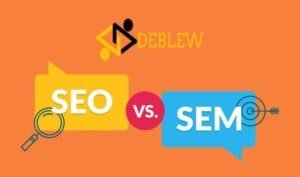Do you want to increase your online visibility and get more traffic to your website? Search engine optimization (SEO) and search engine marketing (SEM) are two effective digital marketing techniques used to accomplish this goal.
To maximize the success of your digital marketing campaigns, it is important to understand the differences between SEO and SEM. This article will explain what SEO and SEM are, the benefits of each, and how to choose between them.
What is The Difference Between SEO and SEM?
Search engine optimization (SEO) and search engine marketing (SEM) are two terms that often get used interchangeably. While they are related, there are some key differences between the two.
SEO focuses on improving a website’s organic ranking in search engines, like Google and Bing, through optimizing content and increasing visibility.
SEM takes a broader approach to digital marketing by encompassing both organic searches as well as paid advertising campaigns to increase traffic to a website.
One of the main differences between SEO and SEM is that with SEO you do not pay for placement in search results; instead, you create content that is visible in the organic search results.
With SEM you can pay for ads or sponsored links for higher placement within search result pages which leads to more traffic being driven directly to your site.
SEO vs. SEM
SEO and SEM are two of the most important digital marketing strategies used in today’s competitive online market.
Both SEO (Search Engine Optimization) and SEM (Search Engine Marketing) help businesses increase visibility on search engine results pages and drive more organic traffic to their websites. But which one is the better option for you?
To decide between SEO and SEM, it’s important to understand how each works. SEO focuses on optimizing a website for organic search engine rankings by using tactics like keyword research, link building, and content optimization.
On the other hand, SEM involves buying ads on search engines such as Google Ads or Bing Ads to get targeted traffic from potential customers searching for products or services related to your business.
Advantages of Using SEO over SEM
Search engine optimization (SEO) is the practice of optimizing a website to improve its ranking in SERPs. Here are some advantages of using SEO over SEM:
- Cost-effectiveness: SEO can be more cost-effective than SEM, especially in the long run, as it involves optimizing your website to rank well in search results organically, rather than paying for each click on an ad.
- Sustainability: While SEM campaigns can be effective in the short term, they may not be sustainable in the long term, as they rely on paid advertising. SEO, on the other hand, can provide long-term benefits, as the improvements to a website’s ranking in the search results tend to be more enduring.
- Trust and credibility: Users tend to trust organic search results more than paid ads, as they perceive them as more relevant and trustworthy. This can lead to increased credibility and trust for your brand.
- Better user experience: SEO can help improve the user experience of a website by making it easier to navigate and use, which can lead to higher engagement and conversion rates.
- Greater visibility: A well-optimized website can rank well in search results for multiple keywords, which can lead to greater visibility for your brand.
Advantages of Using SEM over SEO
Search Engine Marketing (SEM) is the practice of using paid advertising to appear on search engine results pages (SERPs). Here are some advantages of using SEM over SEO:
- Quick results: SEM campaigns can provide quick results, as they involve paying for each click on an ad, which can lead to immediate traffic to a website.
- Greater control: With SEM, you have more control over which keywords your ads will appear for and where your ads will be displayed. This can be particularly useful if you have a specific target audience or if you want to focus on a specific geographic region.
- Targeting: SEM allows for more precise targeting of your audience, as you can choose to show your ads to people who are searching for specific keywords or who fit specific demographics or interests.
- Measurable results: SEM campaigns are easy to track and measure, as you can see how many clicks your ads are getting and how much traffic they are driving to your website. This can help you to identify which ads are performing well and adjust your strategy accordingly.
- Flexibility: SEM campaigns can be easily modified or paused, allowing you to make changes to your strategy on the fly as needed.
SEO vs SEM: Main Features
Search Engine Optimization (SEO) and Search Engine Marketing (SEM) are two methods of increasing visibility and driving traffic to a website. Some main features of SEO & SEM are as follows:
SEO Overview
It helps businesses optimize their content to make it more visible on search engines like Google and Yahoo.
SEO involves optimizing both the technical aspects of a website, as well as its content so that it can be easily found and indexed by search engines.
This allows businesses to increase their visibility online, drive more traffic to their websites, and gain more customers.
On-Page SEO:
On-page SEO is a crucial component of any website’s search engine optimization strategy. This practice involves optimizing individual web pages to increase visibility in the organic search results and improve overall rankings.
By utilizing quality SEO tactics, businesses can ensure their content is easily found and indexed by search engines, helping to drive more traffic and leads.
On-Page SEO consists of several key elements including relevant keyword usage, formatting content for readability, optimizing page titles and meta descriptions, creating internal links between related content, adding images with descriptive ALT text tags, building out XML sitemaps for indexing pages faster by search engines, and utilizing social media to share content with users.
All these techniques work together to provide an optimal experience for visitors as well as increase presence within the SERPs (Search Engine Results Pages).
Off-Page SEO:
Off-page SEO is a major part of any successful search engine optimization (SEO) strategy. It involves activities outside of your website that help to increase your website’s visibility and rank in the search engine results pages (SERPs).
Off-page SEO includes link building, directory submission, social media marketing, content marketing, and other tactics that generate backlinks to your website.
Link building is an integral part of Off-Page SEO. This involves getting quality backlinks from other websites with high domain authority.
This helps to give you more credibility in the eyes of the search engines, which can result in higher rankings for your site.
Directory submission is another key element of Off-Page SEO; submitting your website to directories such as Yahoo! or DMOZ can help spread awareness about your business throughout the web and bring more traffic to your site.
Technical SEO:
Technical SEO is among the integral components of an effective SEO strategy. It includes the optimization of a website’s structure and system for better search engine rankings.
In a world where organic visibility is becoming increasingly competitive, technical SEO can be the difference between a successful website and one that simply fails to get traction in search engines.
For organizations looking to achieve long-term success with their online visibility, technical SEO should be at the forefront of their digital marketing efforts.
Technical SEO covers many areas; from creating an XML sitemap, and optimizing page speed and user experience (UX) to ensuring URLs are structured correctly and redirects are in place.
All these elements must be done correctly if you want your website to climb up Google’s rankings and deliver high-quality organic traffic.
Additionally, having an understanding of how algorithms work will help ensure your content reaches its intended audience as quickly as possible.
User Interaction Signals:
User interaction signals are a crucial component of any design process. They are used to communicate with users, give feedback, and provide direction on how to interact with a product.
From physical buttons and sliders to digital touchscreens and voice commands, user interaction signals can come in many different forms.
User interaction signals should be designed to create an intuitive experience for the user. This means providing clear visual indicators when something is selected or interacted with, or providing audible cues that help guide users through an interface.
By making these cues obvious and easily understandable, designers can create an enjoyable experience for their users that encourages engagement and creates loyalty towards the product.
Additionally, it ensures that the user understands what will happen when they interact with a specific element on the screen or device.
SEM Overview
SEM, or Search Engine Marketing, is an important digital marketing strategy for businesses to consider. It is the process of gaining website traffic and visibility through paid search engine results.
Through SEM, a business can increase its online presence and create more brand awareness for its products or services.
Bidding:
For businesses looking to maximize their visibility on search engine results, bidding in SEM (Search Engine Marketing) can be a great way to ensure their website appears prominently.
SEM is a form of digital marketing that focuses on optimizing content for search engine algorithms, allowing advertisers to reach targeted audiences using keywords and phrases related to their product or service.
Bidding in SEM works by setting up campaigns with optimal bid amounts for each keyword—the higher the bid, the higher the ranking an ad will have on search engine pages.
Advertisers should consider various factors when bidding in SEM, such as budgeting for particular keywords and bids based on competition levels as well as the potential return on investment from those ads.
Quality Score:
Its primary purpose is to draw organic traffic and expand the reach of an organization’s online presence. A key metric used to gauge the success of SEM efforts is called Quality Score, which is assigned by search engines like Google.
Quality Score reflects how relevant an ad or keyword is perceived to be about a user’s search query.
It is based on numerous factors such as the relevance of the keyword, its overall popularity, click-through rate and landing page quality.
A higher Quality Score usually means better visibility in search results and less cost per click for advertisers with successful campaigns.
It also indicates that more users are likely to engage with an advertisement or landing page due to its quality and relevancy.
Ad Copy:
Ad copy in SEM (Search Engine Marketing) is an essential part of any digital marketing strategy. It’s the words and phrases used in search engine ads that help to attract potential customers and convert them into paying customers.
Ad copy should be concise, specific, informative, and persuasive so that it stands out from the competition and gets your message across effectively.
Good ad copy grabs the attention of searchers by using keywords in a natural way that resonates with their needs.
Ad copy should include benefits for prospects rather than just features – describing why they should use your product or service instead of others on the market.
Additionally, ad copy can be tailored to different audiences or customer segments to maximize relevancy and conversion rates.
Ad Groups and Account Management:
Search engine marketing (SEM) is an effective way for businesses to increase traffic to their websites and generate more leads.
Ad groups and account management are two key components of SEM that can help businesses maximize their visibility in the search engine results pages (SERPs).
An ad group is a collection of ads within a larger campaign. Each ad group should target a specific product or service, and all ads within a single ad group should use similar keywords and phrases.
This allows marketers to tailor each ad, so it’s more relevant to the user searching for specific products or services.
In addition, ad groups can be used to test different variations of ads before deciding which one will perform better with the target audience.
Account management is an important part of SEM as it helps ensure campaigns are running smoothly and producing desired results.
SEO vs. SEM: How Long It Takes to See Results?
Search engine optimization (SEO) and search engine marketing (SEM) are two of the most important digital marketing strategies to help businesses increase their visibility online.
But what is the difference between SEO and SEM, and how long does it take to see results?
SEO focuses on optimizing content for search engines, while SEM involves using paid ads to promote a business’s website or product.
SEO requires a longer-term investment in building organic search rankings with quality content, which can take anywhere from three months to one year depending on the size and scope of your project.
On the other hand, SEM involves paying for sponsored ads that appear high on the SERPs when relevant keywords are searched by potential customers.
This leads to quicker results but may require ongoing investments to maintain top positions.
SEO vs SEM: How Much They Cost?
Understanding the difference between SEO and SEM is essential for any business looking to maximize its digital marketing budget.
Knowing what they cost can help determine which of these services best suits your needs and which will yield the highest ROI.
Search engine optimization (SEO) is an organic form of advertising that focuses on optimizing a website’s ranking in search engine results pages.
This type of online marketing requires no money; instead, it relies on content creation, keyword research, metadata optimization, and other strategies to improve visibility in search engine results pages.
While there are certain costs associated with SEO such as keyword research tools or hiring a professional copywriter to produce high-quality blog posts and articles, overall, it is considered one of the more affordable forms of online marketing available.
Which to Choose? SEO or SEM
It can be difficult to know which one is right for your business; however, understanding the difference between the two will help you make an informed decision.
SEO focuses on optimizing content and website structure to improve organic rankings in search engines.
This includes activities like keyword research, page optimization, link building, and technical audits. These efforts aim to drive long-term sustainable growth with little cost or time investment required.
On the other hand, SEM focuses on paid campaigns that target specific keywords or phrases through advertising platforms such as Google Adwords or Bing Ads.
This strategy offers faster results since ads are displayed almost instantly but require higher upfront costs than SEO does.
FAQs
Is Google an SEO or SEM?
Google is both an SEO (Search Engine Optimization) and an SEM (Search Engine Marketing). SEO is focused on optimizing content for organic search engine rankings, while SEM involves using paid advertising to reach a wider audience.
Google offers both services, allowing businesses to optimize their content for better organic rankings and also use paid ads to generate more traffic.
Is Google Ads SEM or SEO?
Google Ads is a Search Engine Marketing (SEM) and it involves creating ads that appear in the sponsored section of search engine results pages. SEM also includes SEO, which involves optimizing content to increase organic visibility on search engine results pages.
Do you need both SEO and SEM?
Yes, SEO and SEM are both necessary for a successful online marketing strategy. SEO helps to optimize your website for organic search engine results, while SEM focuses on paid advertising. Both strategies can help you reach more potential customers and increase traffic to your website.
Which is bigger SEO or SEM?
SEO and SEM are two different digital marketing strategies, but they both work together to help increase the visibility of a website. SEO focuses on optimizing content for search engine algorithms, while SEM focuses on using paid advertisements to drive traffic. Ultimately, SEO has a longer-term impact since it builds organic traffic over time, while SEM is more immediate with its paid advertising campaigns.
Can SEM improve SEO?
Yes, SEM (Search Engine Marketing) can improve SEO (Search Engine Optimization). SEM helps to increase visibility in search engine results pages by using a combination of techniques such as paid listings, organic optimization, and link building. This helps to improve the overall ranking of a website in search engine results and can lead to increased traffic and conversions.
Will SEM affect SEO?
Yes, SEM (Search Engine Marketing) can affect SEO (Search Engine Optimization). SEM involves paying for ads to appear higher in search engine results, which can make it more difficult for organic SEO efforts to be seen. It is important to consider both SEM and SEO when creating a digital marketing strategy to maximize visibility and reach the desired audience.
Final Thoughts
In conclusion, it is important to understand the differences between SEO and SEM to choose the best tool for your business. SEO is based on organic search engine rankings, while SEM focuses on paid advertisements.
While both strategies have their benefits, it is important to consider what will best serve your business’s needs and goals before making a decision. Additionally, it may be beneficial to use a combination of both tools to achieve the best possible results.





